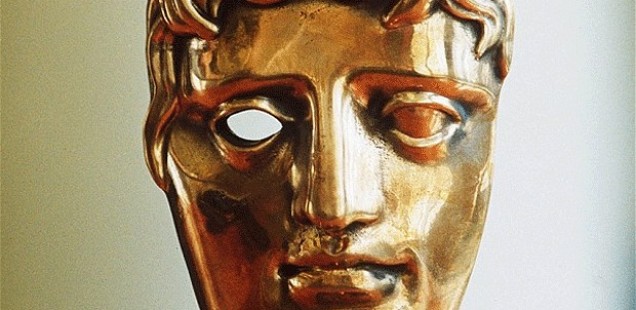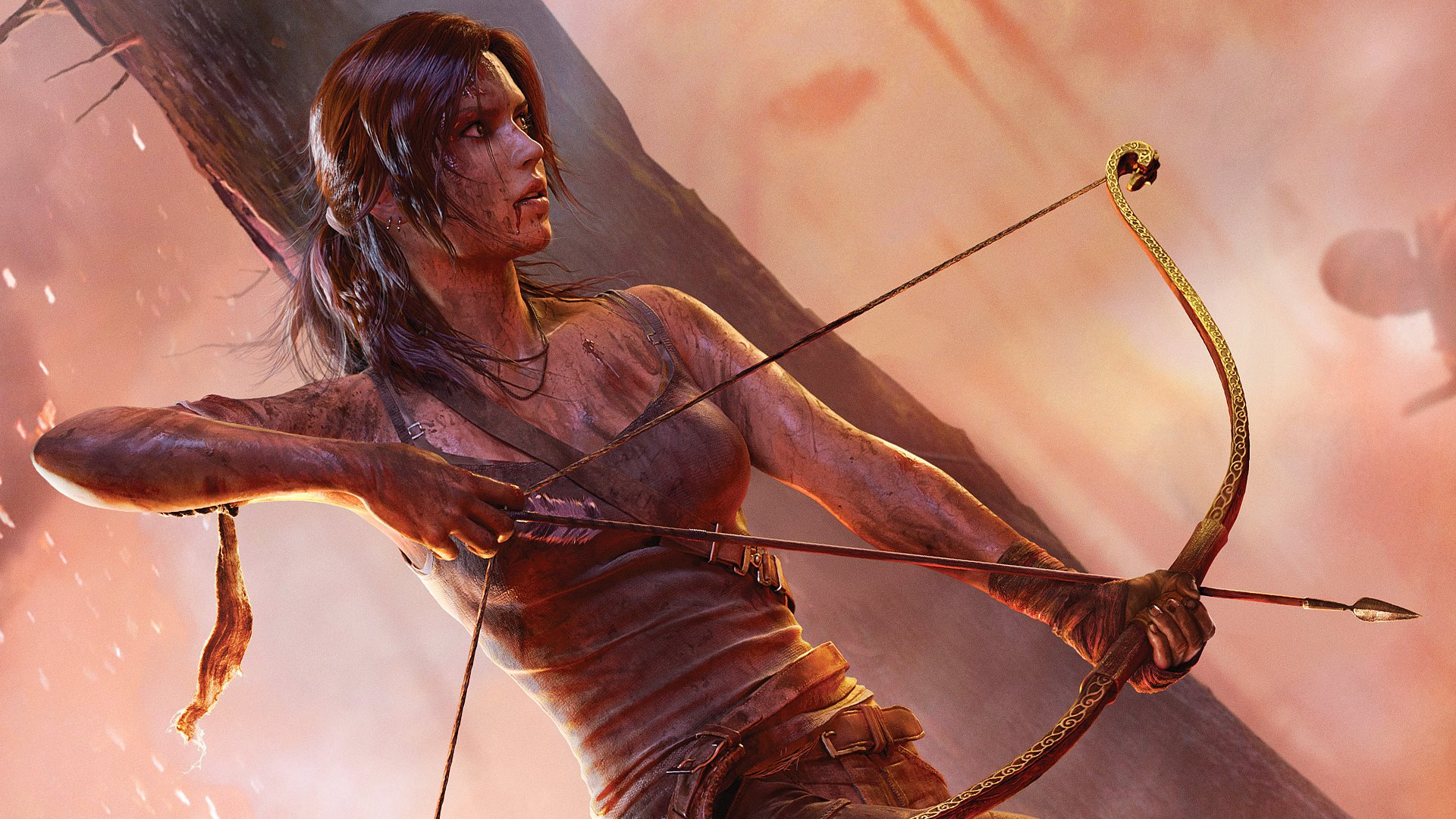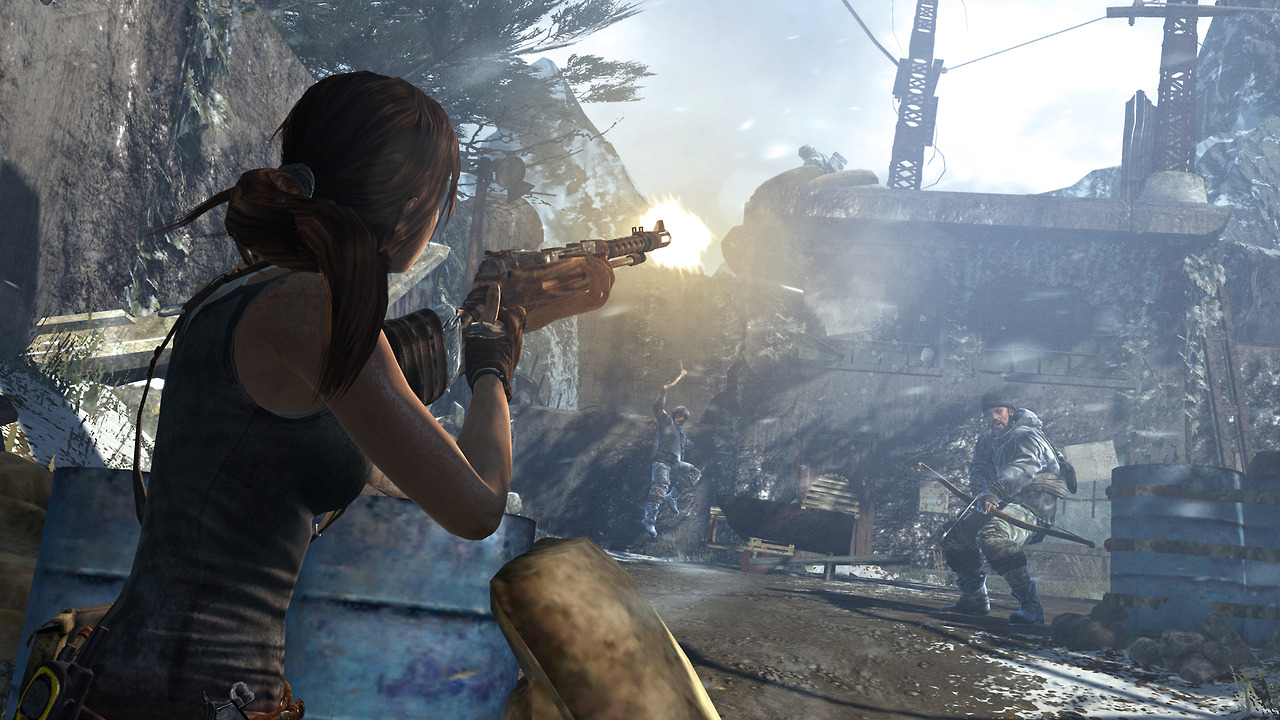
Unnatural Selection
Francisco Dominguez attended BAFTA’s Tomb Raider preview in London for us.
A swanky West End theater, just down the road from Piccadilly Circus, was an unlikely host for a Tomb Raider preview. Despite its substantial commitment to the field, gaming is still the odd one out among interests of the British Academy of Film and Television Arts, hosts of the event. The culture divide felt obvious as I passed through a softly lit bar full of smartly dressed people seated on plush upholstery. One more stairway took me to an area where too many people crowded around too few screens. Game demos. Posters. Teenagers in hoodies. That’s more like it.
Funnelled into the auditorium, we took our inordinately comfortable seats to hear studio head Noah Hughes and creative director Darrell Gallagher share the story of how Crystal Dynamics found the “Tomb Raider DNA”. It began with Guardian of Light‘s success. Seen as proof that a fresh approach to Tomb Raider could work, a planned sequel switched to the invigorating prospect of a reboot. That brief sense of liberty, however, quickly faded once the breadth of obligations to the brand and to the fans became clear. Even with a clean slate, Crystal Dynamics felt a duty to retain the essence of the franchise they inherited six years ago.
So, how do you locate the core of a 17 year old series? An intensive internal debate within Crystal Dynamics endeavored to find out. Gallagher insisted that he maintained editorial control of the studio’s decisions, and that the game was all the better for it: “Group feedback is great, but consensus can spin you in all sorts of directions.”
The aim was to forge a strong emotional affiliation between the player and Lara and a gruelling game experience was Crystal Dynamics’ means to achieve that goal. Operating from the belief that “the stories that we remember aren’t the ones that are easy”, a set of harrowing true stories circulated among the staff to illustrate the desired “emotional weight”. Examples included the Andes Flight Disaster, a plane crash that had survivors resort to cannibalism, and Aron Ralston, a mountaineer who cut off his own arm to free himself from the boulder it was trapped under.
Now that they had picked an emotional tone, gameplay could be designed to support it. Crystal Dynamics’ “Survival-Action” style was devised as a combination of the “three pillars” of traditional Tomb Raider gameplay: traversal, combat and puzzles. All were tweaked to complement the new approach. Traversal became treacherous, paths changing as Lara uses them. Combat is now intended to be desperate and overwhelming. And puzzles use physics simulations, not fiddly block pushing, indicative of Lara’s resourcefulness.
Mixing three broad game styles hardly ensures a textured emotional experience. Recognizing this, Crystal Dynamics brought in the artist’s constant friend, Microsoft Excel, to aid the careful structure and sequencing of game scenarios for heightened effect. No, really. A high level plot treatment, art samples, game scenario overviews and lots of other information were compiled into a terrifyingly vast spreadsheet. Mood is defined by a color key. Scarily extensive categorization like this provides the framework to many other powerful game experiences, but seeing it laid out like that was an impressive, if oddly clinical, sight.
 And what of Lara, the target of this calculated chain of perilous situations? In a Q&A later that evening, writer Rhianna Pratchett described her early reluctance to write the character. Once a keen fan, her enthusiasm gradually turned to apathy as Lara’s design calcified into “a pair of boobs with a pair of pistols.” But the re-imagined Lara’s early concept art displayed unexpected potential. Today, the imagery of a bow feels stale. The Hunger Games has become a phenomenon, and Crysis 3 launched with the same weaponry. But before other franchises co-opted the bow, it introduced vivid, new suggestions of primal capability and self-sufficiency for Lara, which was enough to persuade Pratchett, the studio’s writer of choice, to get onboard. Even if her suspicions that “they were just looking for someone British and geeky with father issues” might have been true.
And what of Lara, the target of this calculated chain of perilous situations? In a Q&A later that evening, writer Rhianna Pratchett described her early reluctance to write the character. Once a keen fan, her enthusiasm gradually turned to apathy as Lara’s design calcified into “a pair of boobs with a pair of pistols.” But the re-imagined Lara’s early concept art displayed unexpected potential. Today, the imagery of a bow feels stale. The Hunger Games has become a phenomenon, and Crysis 3 launched with the same weaponry. But before other franchises co-opted the bow, it introduced vivid, new suggestions of primal capability and self-sufficiency for Lara, which was enough to persuade Pratchett, the studio’s writer of choice, to get onboard. Even if her suspicions that “they were just looking for someone British and geeky with father issues” might have been true.
The writer behind Mirror’s Edge and Heavenly Sword’s heroines wanted to refit Lara to her new environments by making her more relatable. So pre-existing relationships with other characters were introduced, and her financial independence was established to avoid her seeming like “some kind of trust fund babe”. The mandate to tell a “heroic, not a superheroic” story has caused problems, Lara’s constant, audible discomfort in particular receiving prominent attention. While Powerpoint slides can’t capture intentions, if Lara evolves as the developers claim she will, the game could deliver an intriguingly sophisticated character arc. As always, it all comes down to execution. If they aren’t obscured by misjudged decisions, Lara’s personal doubts as her world view collapses could be fascinating drama.
Talk of “experiential game design” principles and design-integrated storytelling ambitions couldn’t hide the compromises writers frequently have to take in games. Pratchett happily admitted to have built the plot from someone else’s early synopsis and created characters to connect with game systems taking form before she came in. Even as a vigilant critic of studios that hurriedly recruit “narrative paramedics” at a late stage, better prepared studios still throw practical inconveniences in her way. A common maxim that character is best expressed by action is inverted in her view of games writing: “With games you’ve already got the action, so you’ve got to work backwards to find the character”. In many ways, different storytelling rules apply.
That ludonarrative dissonance, game storytelling’s unique demon, came up was no surprise. When pre-release footage alternates between showing Lara remorseful over killing a deer and murdering multiple enemies without comment, disparity between character sensibilities and her actions in gameplay is evident. The designers responded with a jarringly conservative answer, concluding that it simply didn’t matter, it’s an acceptable part of the genre, and it’s up to the player to suspend their disbelief.
Pratchett leapt in to explain that Lara’s first kill does influence her, suppressed guilt striking at intervals, but the difference in attitude between disciplines remained striking. Pinning inconsistent characters to genre expectations felt particularly inexcusable. Earlier, they had cited the James Bond and Batman reboots as inspiration for their own efforts. Lacking their monumental creative daring isn’t a slight, but the lack of will to match their disregard for genre limitations is sad.
Tougher questions followed, and once again the answers weren’t always satisfactory. Multiplayer was explained as a long-time ambition, viable now after Guardian of Light provided a technological model. The most challenging question of the night suggested some fans have seen one change too many to a beloved series. A brave “disenfranchised Tomb Raider fan” presented a lengthy list of complaints, citing seemingly borrowed game features as evidence of generic design that removed the “cerebrality” of previous games. The deeply felt grievances were only partially rebutted by the developers, who rejected any similarities to contemporary games as coincidental. Fully engaging with such a wide attack on their game before its release was a commendable response to an impossible situation; they tried, but the issues remained unresolved before the audience Q&A moved on.
At this point, the final game will be the only valid answer to every contentious decision made by Lara Croft’s new custodians. Intense criticism feels premature. The hugely complexity of the task made the many compromises feel like acceptable inevitabilities of the medium: challenges to be overcome, not creative impediments. Even if every accusation of derivative design is accurate, if they contribute towards the emotional power they claim, producing the Lara they aimed to create, perhaps that single accomplishment will be worthwhile.
In the interests of full journalistic disclosure: canapes were served after the event. Francisco Dominguez did not partake, rushing off in search of the toilet.
Francisco Dominguez is an English graduate currently pursuing a postgraduate career in stacking food. You can follow him on Twitter.
